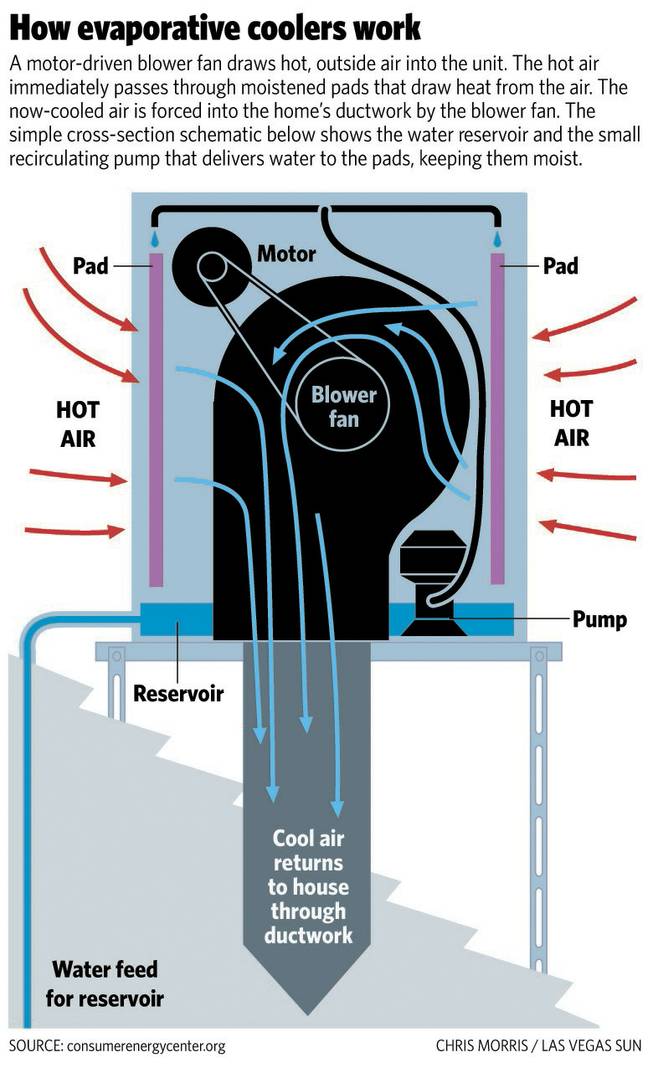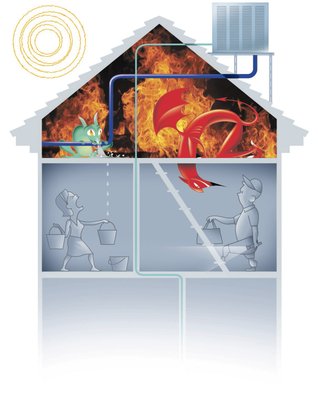Sunday, Aug. 2, 2009 | 2 a.m.
It first spoke to us on a bright spring morning, saying the same thing it always says: Drip, drip, drip.
It was coming from inside the bedroom. Water was sheeting down the windows and more water still was pooling in the walls, bulging the paint like a hernia. It was the drops of water falling on our pillows and faces that woke my wife. She shook me awake after realizing it was raining inside.
I suspected the swamp cooler instantly, the way a dug-up flower bed makes you suspect the dog or the way discovering dozens of bodies in a crawl space makes you suspect the presence of a serial killer. Onto the roof I went, using the ladder that hadn’t been put away from last summer.
The swamp cooler was dry, its shut-off valve tight.
I scrabbled into the attic. Where were the pools of water, where was the flood? The flashlight beam found a mist of water, spraying out of a pinhole in the black plastic tube leading to the swamp cooler. Water collected on beams and ducts.
Drip, drip, drip.
• • •
This is our second summer with the swamp cooler. Last year, it confined its leaks to the roof and we fixed it with a new float, a new pump, a dozen cans of Rust-Oleum and one case of heatstroke.
This is our second summer in the house. We bought it as a fixer-upper, figuring it was the only way to get into our neighborhood, a place where children play unsupervised in the streets and the neighbors wave and talk. We should have been wary. If horror movies have taught us anything, it’s that every suburban idyll conceals a monster.
Before we bought the house, we had a couple of building inspectors go through it. Good bones, they said. When friends and family asked about all the work it needed, we said, “Good bones.”
Do you know what else has good bones? A tar pit.
About tar pits: The effective ones were covered in water, looked like inviting places of peace and respite. That’s what lured in all those cautious mammoths and savvy saber-toothed tigers. Then: glug, glug, glug.
In 2007, the house looked good. Sure, it needed work, but it was about 60 grand less than its well-kept subdivision cousins. Plus, the housing market had passed its peak and we’d be buying on the way down, which was true, it’s just that we forgot what parabolas look like. They look like a roller coaster — tick, tick, tick-tick, tick-tick-tick, tick-tick-tick ... AIEEEEEEEEEEEE!
We bought at the second tick.
It’s not important what it’s worth now. What’s important is that it is trying to break us, stripping away our flesh knuckle-by-knuckle.
The house is not merely a fixer-upper, it is also a breaker-downer.
My best guess is the previous decade or so of its life was not heavy on repairs and upkeep. Plus, I’ve looked at some of the original construction. Let’s just say it’s one thing to drive a Honda for 10 years without a tuneup and it’s another thing to neglect a Plymouth.
Consider the past six months:
One shower started leaking like a cardboard submarine. The air conditioner needs to be recharged. The door to the ice machine on the refrigerator is broken and held in place by a wadded-up rag. The garbage disposal’s blades shattered. The circuit breaker box has moods. (The hot tub leaks, but that’s the least of our worries. Have you been outside lately?)
And there is, of course, the swamp cooler, Neanderthal cousin to the air conditioner.
It’s basically a box with water in the bottom, which is pumped into straw-filled panels on the side. A wheel fan in the middle pulls outside air through the panels and down into the house. It cools for the same reason sweat cools: evaporation. Maintenance and repairs are simple, and occasionally easy, which is fortunate because as a swamp cooler ages, it suffers from drooling and incontinence.
Which is not to say that treachery does not also come into it. In the pantheon of household demons, the swamp cooler is right in there with the worst of them, sporting goat horns, insect wings and the face of a toad.
The leak in May didn’t seem possible because the plastic feeder line had been turned off. I thought.
It turns out a valve in the garage had stuck halfway open. Out of sight, in the darkness and heat of the attic, the line sprung a leak, water pooled on the insulation and started soaking down through the drywall.
The insurance man insisted we turn off all water to the house and not turn it back on until a plumber fixed it. In the meantime, they sent over a damage-repair team, which stripped off half a wall, cut holes in the ceiling, ran giant fans and declared that the water was leaking out of a natural gas pipe. The plumber came three days later and fixed the pinhole leak in five minutes flat. Eighty dollars.
Why do we put up with this? Because the swamp cooler, like all good demons, tempts. Last July, for instance, with the swamp cooler running, the electric bill was about $135 — $200 less than it might be. The houseplants thrived in the humidity. And for us, it was a summer without nosebleeds.
And so we sacrifice to our rooftop Ba’al.
Like the $150 I paid to have the panels sandblasted this year. Then I primed and painted the panels with about a dozen cans of tarry black undercoat and official swamp cooler beige. Two days later, the paint started peeling off.
In desperation, I turned to David McKinnis, who manages the Mirage’s cooling system. He showed me the computer system that monitors and adjusts the pH of the water in his cooling towers. It was like touring a battleship to figure out how to repair a rowboat. Luckily, McKinnis has his own swamp cooler. He also spent a couple of decades installing and maintaining them on houses. I asked him, what should I do? Allow me to paraphrase his answer: Son, no dog lives for ever, not even Champ.
I went home and started it up. Come on Champ, you can do it boy. Another year or two, how about it?
And it worked! Worked great. Cool, moist air. Happy plants.
And then, on a Friday in July, I came home to find the bedroom floor covered in water. It came out of the unpatched holes in the ceiling.
The feeder line had sprung another leak. In the attic. In Las Vegas. In July. In the late afternoon.
Up I went. It’s harder than you’d think to hold onto and splice a piece of plastic when your body is trying to convert your blood into slippery sweat.
That Sunday morning, I went into the attic for another hour or so and replaced the whole line. After the first 20 minutes, I stopped sweating and after another 20 minutes I felt quite cool. True, these are signs of heatstroke and kind of worrisome. A cool, fuzzy kind of worrisome, all the way over there, somewhere.
And while I was up there, I noticed the attic fan had died. You notice the little things, north of 140 degrees.
Now the house, unnatural disaster that it is, has not at all times been a beneficent force in our lives. It has not often poured oil over the troubled waters of our marriage. Usually, it does cannonballs.
But on Monday night, when I climbed back into the attic to install a new fan, my wife was already up there. She had cleared the way to the fan and carried up the tools. She stayed up there, holding the flashlight, sweating alongside me.
Climbing down later, I looked at her and thought how, if it hadn’t been for the house and the swamp cooler, there would be things I wouldn’t know.
The bonds of our marriage extended even unto attics in July. I think about it still.
And the next day, I hired somebody else to fix the drywall.



Join the Discussion:
Check this out for a full explanation of our conversion to the LiveFyre commenting system and instructions on how to sign up for an account.
Full comments policy